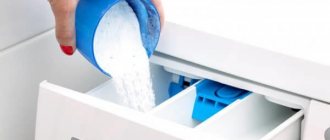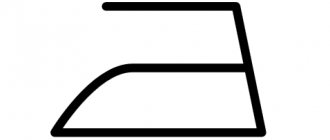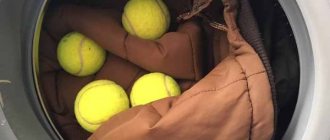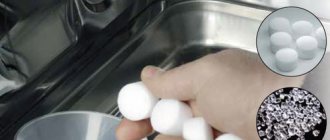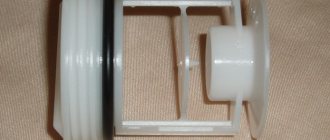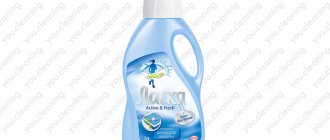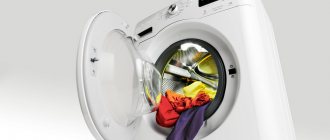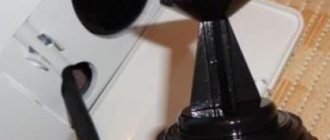When using washing machines, it is important to adhere to the operating instructions. This is especially true for the use of laundry detergents. You need to know where to put the powder in the washing machine, since the special container has many different compartments for different household chemicals.
Additionally, many housewives try to reduce the consumption of the product by sprinkling it on things. This is not recommended.
Where to put powder in the washing machine
There are manual cars and automatic cars. The type of device determines where the detergent will be poured.
Mechanical devices do not have a container for loading powders, so the substance is placed directly into the tank. But you can't put bleach/stain remover in here. The product is selected for manual action, which means it will not worsen the condition of the tissues.
In automatic devices there is a specially designated tray, in which there are several compartments designated by letters or numbers.
[custom_ads_shortcode1]
Powder tray in different types of machines
The powder tray in the devices is placed in accordance with the type of loading. For a top-loading fixture, the fixture is mounted from the inside into the lid. For horizontal ones, it is located on the front panel.
Each tray consists of several cells and is marked. The variation depends on the model and manufacturer. Compartment options:
- “A”, “I”, “1” – the department is activated when the “Pre-wash” or “Soak” mode is set. Granules are poured here and a liquid product is placed.
- “B”, “II”, “2” – basic compartment for powder or gel detergent. The tank is activated in any operating mode.
- “C”, “star”, “flower” - container for conditioner or rinse aid. The compartment is active during the rinsing process during any wash cycle. Excipients are also added here - blue, starch, gelatin.
In modern models, numbers to designate containers are rarely found; it is worth focusing on letters. If the markings have already been erased, then the largest compartment is the base one. Smaller containers are used only in certain modes. Small tray - for conditioners and rinses.
[custom_ads_shortcode2]
Standard marking of trays for loading detergents and their purpose
There are “washing machines” that are not equipped with a compartment for filling detergents, but if such equipment is present, then it is important to know exactly which section is responsible for what. Often the tray is divided into three containers, masked with a certain symbol. Let's take a closer look.
| Symbol | Explanation and purpose |
| I (1) or A | This compartment is designed to be filled with washing powder or liquid gel detergent. During operation, the washing machine fills this container with water only if the selected washing function provides for pre-cleaning of items. You can also place bleaches and stain removers in this compartment. |
| II (2) or B | This marking indicates that the tray is intended for loading powder or any detergent for the main wash. |
| * ❄ star or snowflake | In terms of size, this compartment is usually the narrowest and smallest; its function is to wash out fabric softeners or fabric softeners. Begins to be used only during the last rinse stage. |
Good to know!
Do not place bleach or stain removers directly into the drum. Even the correctly selected washing mode will not save the item from damage.
Is it possible to put powder directly into the drum?
Some housewives try to save money and pour money into the drum of the machine. But not all products can be placed directly inside:
- Any gel can be poured directly into the centrifuge.
- Conditioning agent can also be poured into the drum immediately before rinsing.
- The capsule, consisting of gel and conditioner, is placed exclusively in a centrifuge.
- Stain remover, bleach and chlorine-containing substances are strictly contraindicated to be poured directly onto clothing.
- The use of granules of any size directly onto laundry is strictly contraindicated.
Important! Even when using gentle programs, the powdered product should not be placed in a centrifuge.
[custom_ads_shortcode3]
Where should I put my laundry detergent?
It is strictly not recommended to use preparations for manual treatment of laundry: they cause strong foaming, which can lead to clogging of the hose and, as a result, to leaks. Powder is poured into different types of washing devices in different ways. Semi-automatic machines usually do not have a separate cuvette for detergents; the powder is poured into the tank along with the laundry.
In machines with vertical loading, the cells for washing powder, conditioner and other products have larger parameters than in front-loading machines. In machines with vertical loading, cells for powder, conditioner, and bleach are located on the inside of the hatch located at the top.
For front washing machines, the detergent compartment is usually located in the upper left corner. Depending on the brand, its design may vary.
Let's take a closer look at the design of the powder tray. The retractable cuvette, designed to bring detergent into the drum, has a well-thought-out device. As a rule, it is made of plastic: the front panel is the color of the body, and the inner surface is white or gray.
This figure shows a schematic representation of a standard compartment for receiving detergents, consisting of three cells of different sizes. The device is divided into three, less often into four compartments, which are marked with letters, symbols, Roman or Arabic numerals:
- The largest module , designated by numbers II, 2 or letter B , is filled with the product necessary for the main washing cycle.
- The compartment is medium in size , marked with the numbers I, 1 or the letter A , designed for filling with washing powder, which is used for pre-washing clothes. You can also add bleach or stain remover here.
- The smallest compartment , which is usually located on the left, is intended for filling flavors and conditioners. This part can be marked with the numbers III, 3 , the word Softener , and the image of a flower (star).
To regulate the amount of softening agent, a limit strip with the word "max" is often applied to the conditioner compartment, indicating the limit limit.
In some models, for example, in Samsung machines, a special dispenser included in the kit is used to apply liquid products. It is inserted into the corresponding compartment of the cuvette. In some cases, this compartment is divided into two parts by a partition, and a removable module can also be used. One of them is intended for the conditioner itself, the second for diluted starch, flavoring or other additional substance.
[custom_ads_shortcode3]
Powder compartments
All modern automatic washing machines contain a pull-out tray. It is loaded with bleach, washing powder and other detergents. Its location may vary depending on the type of machine.
- In washing machines with horizontal loading, the powder cuvette is located in the upper part of the device above the hatch.
- In machines with vertical loading, the cuvette is located on the hatch cover or on its inner side.
The tray contains three compartments. Not all owners of washing equipment know the purpose of each cell. Therefore, they make mistakes at this stage of washing.
- The smallest compartment. It is usually indicated by a snowflake, flower, or star icon. It is intended for rinse aids and conditioners.
- Medium sized compartment. Suitable for delicate or pre-wash. It also contains products that are needed when soaking things.
- Largest compartment. Designed for washing powder or other main wash products.
READ MORE: Kitchen Factory Medyn: reviews from clients and customers about the company
On some machines, the medium and large compartments have the same capacity, but are labeled differently. They are designated by letters (A and B) or numbers (I and II).
If the cell markings have been erased due to the use of washing equipment or are completely absent, then you can find out the location of the compartments as follows. You need to turn on the washing machine with an empty drum, and then select a program without prewash.
The powder compartment must be left slightly open. Then you need to monitor which compartment the water will flow into. This compartment is used for the main wash and you need to load washing powder into it.
Semi-automatic washing machines do not have a tray for washing powder. In them, the main powder is poured directly into the container for washing things.
Rules for loading detergent
The powder is poured into the cuvette randomly; it is not at all necessary to distribute it evenly throughout the entire container: the main thing is that it does not spill out over the edges. After the manipulation, you need to close the compartment tightly, and only then start the machine.
When choosing a mode that includes a pre/main wash and rinse using fragrance and softener, all products can be added to the cuvette at the same time. Some washers have levels in the cells that allow you to control the amount of detergent added. However, housewives often pour the powder by eye, remembering the amount from previous washes.
The design features of the machine ensure that detergents (powder, conditioner) enter the drum along with the flow of water supplied through the tray. Each compartment has holes that create conditions for dissolving these products with a stream of water and transferring them to the tank.
Complete transportation of substances is facilitated by both the high pressure under which water is supplied and the smooth walls of the powder receiving device, which facilitate the release of the dissolved product.
[custom_ads_shortcode1]
When do we add powder to the drum?
This measure is forced: it has to be resorted to if the detergent tray is damaged.
Do not add aggressive products (stain removers, bleaches) to the drum, as they can stain the fabric or even destroy the material. It is also not recommended to add powder containing multi-colored granules directly to the laundry, as they can leave marks. In this case, you should first find out whether the compartment really does not cope with the proper functions. This can be done simply: carefully inspect the item after washing. If residues of detergent are found in it, it means that it was not washed completely due to malfunctions.
[custom_ads_shortcode3]
Pros and cons of the alternative method
There are different opinions about adding detergent directly to laundry. Supporters note the following positive aspects:
- In this case, the amount of detergent can be reduced , since it comes into contact with things.
- This method increases the service life of the machine , and also relieves the user of caring for the tray, which is one of the most problematic components of washing units.
- If powder particles get through the ditch, they can stick to the inner walls and then get onto the laundry when rinsing. This does not happen when you put it in the drum, so things are rinsed faster and better.
At the same time, there are a significant number of disadvantages:
- In the compartment, the powder is washed out with water, entering the drum already partially dissolved. When adding the product directly to the laundry, it will take much longer to dissolve.
- Washing powder granules that fall on dark-colored items may leave light marks.
- If the product is poured onto the wall of the drum, then at start, part of it will be pumped out by the pump along with the water remaining in the tank from previous washes.
- Some wash programs that require batch use of detergent will not be available if detergent is added to the drum.
- There is no point in adding powder to the drum when planning a pre-wash or soak. Such modes involve draining the water after passing the initial stage; Along with the liquid, the detergent dissolved in it will also leave, which will not wait until the main stage of the cycle.
- It is also not possible to use this method to add conditioner or other rinse aid, which should only be added at the final stage of the process.
The use of a special container will partially avoid the negative consequences: a plastic jar with holes marked on the lid. The detergent poured into it will flow into the water gradually and will not be washed out immediately. At the same time, this method will not solve the problem of using conditioners or other rinses.
[custom_ads_shortcode1]
What products can be added to laundry?
At the same time, there are a number of modern products that, according to the advice of manufacturers, must be introduced into the drum. Such substances include:
- Powders made from soap . These substances have a coarse granular structure, which can clog the hole in the cuvette, which can lead to leakage and flooding of neighbors.
- Phosphate-free powders , as well as products for the production of which plant extracts .
- Powders for washing children's clothes : pouring into the drum makes it easier to rinse clothes.
- Modern varieties of detergents, available in the form of gels, capsules, and compressed cubes, .
It is not recommended to add gel-like preparations to the cuvette: due to their thick consistency, they are slowly washed off with water. Because of this, their residues can enter the tank already at the final stage of the cycle during rinsing and spinning.
Gel and liquid detergents are not recommended for use at high water temperatures, therefore, when using them, you should choose modes that provide maximum heating of +60 ° C. If for some reason gels need to be added to the tray, it is recommended to first dilute them with water. The capsules were specially designed for use in a drum; other options for their use are not provided.
All these products can be added to the drum in different ways:
- pre-dilute with water;
- pour directly onto laundry;
- place in a special bag (this option is especially recommended for powder based on plant raw materials).
Sometimes housewives have to deal with situations where it is not possible to determine the purpose of the tray compartment (faded markings and the inability to check the instructions). In this case, it is quite possible to recover the information experimentally.
To do this, run the device in the no-soak mode, leaving the detergent drawer slightly open. If you look into the cuvette at the very beginning of the cycle, you can see how water will flow into the compartment intended for washing powder.
[custom_ads_shortcode2]
Is it possible to pour detergent into the drum?
If there is no limiter, you can pour the gel directly into the drum . However, if part of the water filled with SMA is pumped out before washing, the product will be removed along with it.
To avoid this, you need to pour the gel into a special dispenser. Some of them (for example, Persil) are sold complete with a dispenser container.
Products that can be added to the drum include:
- Phosphate-free and environmentally friendly gels.
- Liquids for washing children's clothes (without bleaching components).
- Very thick concentrates that do not wash out of the tray.
If for some reason a thick, concentrated product needs to be poured into a cuvette, it should be diluted with a small amount of water. It is prohibited to pour enzyme stain removers and bleaches into the tank without a container!
Determining the optimal amount of funds
Depending on the selected program, the following products must be added when washing products:
- For simple washing, just pour the powder into the cell marked with the letter B or the number 2 (II).
- For a full cycle with soaking and rinsing with the addition of softener, powder is loaded into compartments A and B, and conditioner is poured into the tray marked with 3 or a “flower”.
- If the laundry is not heavily soiled, you can do without pre-soaking. In this case, it is enough to add detergent to compartment B (II); If desired, rinse aid can also be added to the small compartment.
Conditioner (fragrance, rinse aid) can be poured into the tray at any stage of the process until the start of the final stage (rinsing and spinning).
[custom_ads_shortcode3]
Rules for downloading other tools
In addition to gels, fabric softeners, stain removers, powders, etc. can be used when washing.
They must be loaded into the following compartments:
- Powder - in compartment I or II, depending on the program, bulk products for starching - only in tray I.
- Liquid bleach - in the gel section or a special container.
- Tablets, capsules - into the drum.
- Stain remover - spot on linen, in a compartment or container, depending on the consistency.
- Balm and conditioner - only in the section with a limiter, marked with an asterisk or flower.
What affects the amount of powder?
The amount of detergent required for washing depends primarily on the volume of items loaded into the machine. In addition, factors such as:
- degree of soiling of the laundry;
- hardness of water;
- amount of water required for washing;
- selected program;
- washing technology.
The more stains on the products, the higher the consumption of detergent. If the stains are complex, it is better to use a stain remover or bleach.
An alternative to industrial water softeners can be a few tablespoons of baking soda, which is added to the powder compartment. You just need to keep in mind that this product cannot be used when washing wool and silk items. Washing in soft water requires less powder than in hard water. To determine what type of water is in your region, just look at the transparent window when you start washing. If bubbles are visible on it, it means that soft water is flowing from the taps.
The liquid can be softened artificially by adding a special product containing phosphates to the washing powder. A large volume of washing water implies an increased content of detergents.
Different modes involve the use of a certain amount of washing powder. In some cases, the difference can be striking: for example, when washing 3 kg of laundry in the “Cotton” mode at +60 °C, 6 tablespoons of detergent will be required, whereas when choosing the “Synthetics” program at +40 °C, only three are required.
It is also necessary to use liquid gel in a certain amount. Increasing the laying rate only leads to wasteful use of the product, while the quality of washing remains unchanged. Innovative solutions used in modern models of washing machines from the best manufacturers make it possible to reduce the consumption of electricity, water, and detergents.
Such technologies include:
- “smart bubbles” EcoBubble;
- steam wash.
In the first case, a special foam generator is used, with which the powder is mixed in water before it enters the drum. Under the influence of bubbles, the product penetrates better into the fabric structure, effectively removing dirt, which helps save powder.
Steam washing involves applying a heated jet of water to items placed in a drum. This technology promotes the rapid dissolution of detergents and the effective removal of contaminants, including old ones. In this case, the water temperature is chosen arbitrarily; it does not necessarily need to be heated to high temperatures. Important advantages of steam washing include the radical destruction of germs and allergens.
[custom_ads_shortcode1]
Calculating the proportions of detergent
You should not thoughtlessly pour household chemicals into the washing machine tray. Exceeding the norm threatens increased foaming, which can lead to clogging of the hose and leaks. If you do not calculate the consumption and add little detergent, the laundry may not wash well.
Some expensive models have an automatic detergent dispensing function. In this case, the machine is loaded with a large amount of the substance used for washing, and then it measures the required amount, focusing on the weight of the laundry. We will try to determine exactly how much detergent powder should be poured into the washing machine.
As a rule, the label of any product contains dosage information, and sometimes the manufacturer supplies the pack with a measuring spoon or cup. According to the manufacturers, 115 grams may be required to wash clothes, and even 225 grams for heavily soiled items.
Experience shows that good washing results can be obtained using much less detergent. For lightly soiled items, it is enough to add one heaped tablespoon of powder (25 g) per 1 kg of laundry. If things are heavily soiled or washing is carried out in very hard water, it is recommended to increase the dose to 1.5-2 tablespoons per kilogram.
It is not recommended to exceed the consumption rate of detergent, not only because of savings: if there is an excessive amount of washing powder, whitish stains remain on things. Concentrated powders, which include Japanese detergents and Amway products, are beneficial to use. Their proportions are calculated regardless of the amount of laundry loaded: only 2 tablespoons of detergents of this type are sufficient for any cycle.
If you use capsules, you should know that one element is enough for a cycle, regardless of the load.
On the presented table you can see the approximate consumption of washing powder required for various washing modes, taking into account the quality of water. Liquid and gel-like products are usually added at the rate of 1 tablespoon per cycle (regardless of the volume of things), with hard water it is recommended to increase the amount of detergent to 2 tablespoons .
[custom_ads_shortcode2]
Caring for the washing machine cuvette
In order for the powder receptacle to work properly for a long time, it is necessary to follow a number of recommendations.
After each wash, it is necessary to remove all remnants of laundry detergents (rinse aid, powder), as well as excess moisture, and then dry the cuvette, leaving it open. Periodically, air conditioner must be poured into the compartment. After soaking, the cuvette is removed from the niche and then thoroughly washed with a brush.
At the same time, the walls of the hole are also cleaned, where dust and accidentally spilled powder often accumulate.
[custom_ads_shortcode3]
Conclusions and useful video on the topic
The video below tells you how much detergent you need to add when washing in an automatic machine: To wash clothes efficiently with minimal powder consumption, you need to take into account a number of factors.
To determine the required amount of detergent, you need to take into account the volume of laundry loaded into the automatic machine, the hardness of the water used, the degree of contamination of the products, and the features of the mode selected for washing.
In addition, you should also follow the recommended algorithm of actions, correctly placing washing powder or other product into the cuvette intended for it.
Would you like to talk about how you load powder into the washing machine cuvette? Do you want to share tricks and secrets of backfilling that will be useful to site visitors? Please write comments, ask questions, post photos on the topic of the article in the block form below.
Compartments in a washing machine: their purpose, differences and designations. What product and where should I put it in the washing machine? Is it possible to pour powder directly into the drum of a washing machine?
An automatic washing machine is perhaps the most useful invention according to women all over the planet. This device saves a lot of time and effort. In addition, it protects the delicate skin of women’s hands and also protects it from the harmful effects of water and chemicals. It would seem that there is nothing easier than throwing laundry into the machine and starting it up.
But it's not that simple. Many housewives quite often have difficulties with intricate compartments for detergents. Despite the fact that there are only three of them (and sometimes 2), women are afraid of harming their new assistant and do not risk using them to the fullest. This article will try to correct the current situation and help our lovely ladies in solving their problems.
[custom_ads_shortcode1]
For fans of capsules and tablets
You can also put modern detergents – capsules or tablets – into Candy. They are placed directly in the drum and wash stains no worse, and sometimes better, than conventional gels and powders. This chemistry also has several undeniable advantages: ease of use, compactness, economical consumption and enhanced action due to its balanced composition.
Now about the difference between capsules and tablets:
- capsules are a gel in a special soluble shell;
- A tablet is a compressed powder that dissolves layer by layer.
There is another type - washing wipes, which also dissolve during the washing process. They all work the same and are not cheap.
Interesting:
- Where to pour powder in a Gorenje washing machine
- Where do you put the powder in the washing machine?
- How to wash gel in a washing machine?
- Where to put the powder in the Ariston washing machine?
- Where to put the powder in the Ardo washing machine?
- Where to fill the conditioner in the washing machine
Reader comments
- Share your opinion - leave a comment
Why are there three compartments in an automatic washing machine and their designations?
What is the purpose of each compartment in a washing machine?
There are three compartments in a standard automatic washing machine. Each of them is marked with special symbols for ease of use and identification:
- The letter A or the number I mark the compartment for powder used in pre-washing. Some machines do not have this mode, so there is no such compartment either.
- The letter B or number II marks the compartment into which you need to add detergent for the main wash.
- An asterisk or flower designates the compartment for adding rinse aid (conditioner or rinse aid).
How are each of the compartments in the washing machine designated?
If a combination of circumstances occurs when the designations for some reason become invisible, the purpose of the compartment can be determined by its dimensions.
- The smallest compartment is for conditioner/rinse aid.
- The second largest compartment is used in the prewash mode.
- The largest compartment needs to be filled with detergent for the main wash.
Another life hack for finding a compartment for the main wash is to start the machine without powder. During startup, you need to slightly open the drawer with compartments and wait for water to fill. The water will enter the main wash compartment first.
[custom_ads_shortcode2]
Options for loading washing powder into automatic machines from different manufacturers: photo instructions
If you correctly study the design of trays in modern washing machines, understanding the method of loading detergents is not so difficult. However, to make it easier to find the right compartment, our editors offer visual instructions with photos for each individual brand of popular automatic washing machines.
Features of the structure of the trays in the Indesit washing machine: where to pour the powder into them
Most modern washing machines from the Indesit brand have three compartments for storing detergents. The widest tank, indicated by the arrow, is intended for dry powder or liquid detergent for the main wash cycle.
Where to put powder in an LG washing machine for the main washing function
In washing machines of the LG brand, the placement of trays is individual, for example, the compartment for placing rinse aids or conditioners is located right in the depths of the pre-wash tank. But you need to pour powder for regular washing of things into the compartment with icon II, as shown in the photo.
Where to put washing powder in a Samsung automatic machine?
Regardless of the model of Samsung washing machines, the internal structure of the detergent tanks is practically the same. Take a look at the photo where to correctly send the powder for the main washing cycle. If you are using liquid products or capsules, they must be placed directly into the drum.
Helpful information!
If you hold the tray open for a few minutes while the wash is running, you will see where the water is collected first, and accordingly, you will be able to determine where to send the powder.
In which compartment of the Bosch washing machine should I pour pre-wash powder?
In the previous section, you have already become familiar with the methods of marking trays for detergents. If you need to thoroughly wash laundry or remove stains from children's clothing, you need to start the pre-wash mode, respectively, pour washing powder into the compartment marked (I), see photo.
Where to put powder, bleach, conditioner in the washing machine: compartments
Which compartments of the washing machine contain powder, conditioner, and fabric bleach?
- Washing powder is placed in the largest compartment, marked with the letter B or number II.
- Pre-wash powder must be distributed into the middle compartment marked with the letter A and the number I.
- Air conditioning should only be poured into the smallest compartment, indicated by an asterisk or flower. In addition, you can add such a product not only before starting the wash, but also during the washing process. In this case, the main task is to fill the conditioner before rinsing the laundry.
- Bleach, machine anti-scale protectants, stain remover or powder enhancer must be poured into the main wash compartment.
Important! If you mix up the compartments and add laundry detergent incorrectly, you can waste a lot of time and money in vain, since the result is unlikely to be satisfactory. Also, do not put harsh products such as bleach or stain remover into the rinse aid compartment.
[custom_ads_shortcode3]
Where to pour liquid detergent into the washing machine and how to choose it
What kind of liquid to pour into cars: Samsung, Ariston, Bosch, Indesit. Almost every modern automatic machine has special symbols on the tray, through which you can determine where the washing liquid is poured. If the compartment has a sign in the form of the Roman numeral 1 or the letter A, then this particular tray is used for soaking.
If the powder is liquid, but is used for regular washing, then it must be sent to a tray marked B or Roman 2, the translation of which indicates its intended use for standard powder, regardless of its type. This tray must be filled out. It is worth noting that it is not always necessary to use conditioner when washing with liquid powder, since some products already contain a component that is responsible for this moment. Liquid powders have their advantages and disadvantages, which you should definitely pay attention to when choosing them.
Before using liquid powder for the standard mode, you need to pay attention to a number of points:
- The amount of powder used in liquid form is significantly lower than when using regular powder. There is a completely logical explanation for this, since the liquid product is washed out faster, but this fact is most often noticeable in new washing machines. If the device is old, then the regular type of powder is washed out more slowly, which can affect the quality of the wash.
- Some liquid laundry detergents are added to the washing machine in a diluted state, as indicated by the information on the packaging.
- If the liquid powder has a pronounced bleaching agent, then it should be added in limited quantities, and also only for a certain type of laundry, in order to prevent damage to colored items and their fading.
- It is strictly not advisable to use direct loading of liquid washing powder, since direct contact with laundry and due to the high concentration may also cause damage to items.
- It is strictly forbidden to pour the product into the drum as an addition to regular washing powder. Due to the strong impact on things, the same chemical reaction occurs as in the previous paragraph. The result will be damage to the linen and wasted money.
READ MORE: How and with what to clean a washing machine: the best ways
The choice of powder should be made not only according to personal preferences, but also according to: the color of the laundry being washed, the degree of contamination, the effect required, cost, smell and additional effects. The most important thing is that the powder is of really high quality and can fully justify the investment.
Is it possible to pour powder into the drum of a washing machine?
Is it possible to pour powder directly into the drum of a washing machine?
Some thrifty housewives wonder whether it would be better to pour the powder directly into the drum. It is impossible to answer this question unequivocally, so we will try to list all the advantages and disadvantages of such washing tactics, and then weigh them.
Advantages
- When adding powder directly into the drum, significant budget savings are noticed - much less powder can be used.
- Rinsing is more efficient because the powder is rinsed directly from the drum. When loading powder from the machine compartment, there is a possibility of it sticking to the internal parts of the machine and the penetration of its particles into the laundry during rinsing.
- You can use this method if the powder compartment is broken.
- Special detergents such as capsules and gels have proven themselves very well. According to the instructions, they must be loaded directly into the drum before washing.
Pros and cons of pouring washing powder directly into the machine drum
Disadvantages
- When loading powder directly into the drum, it is advisable to run a longer wash cycle at high temperatures (over 40 degrees) so that the powder is completely dissolved. The fact is that with indirect loading, the powder additionally dissolves before entering the drum.
- Preliminarily emptying the drum of water before washing can wash out a large amount of powder. To prevent this from happening, it is best to use special containers for powder sold in stores.
- By pouring powder directly into the drum, the possibility of pre-washing is eliminated. This mode becomes unavailable, and you cannot pour powder directly into the drum after pre-washing.
- If the washing detergent compartment in the machine is broken, you can still add powder directly, but you won’t be able to use conditioner or rinse aid, since such detergents are used in washing only at the rinsing stage.
- Direct loading of powder eliminates the possibility of using bleaches and stain removers, since it is very dangerous to pour them directly.
Our dear readers, we hope that now, when you open the washing machine drawer for powder, you will not be stunned, but will quickly figure out what needs to be put in where.
[custom_ads_shortcode1]
Can it be placed directly into the drum?
Under no circumstances should you try to pour washing powder into the drum of the machine.
During each washing cycle, the device draws in and releases water many times, so the products that will be placed in the drum are spent ineffectively. Such inappropriate use of powder will result in things remaining dirty . In addition, the detergent is dosed into the drum from a special section, which ensures better washing.
The exception to the rule is capsules. Unlike washing powder or gel, they are placed directly into the drum. The manufacturer indicates this information on the packaging.
